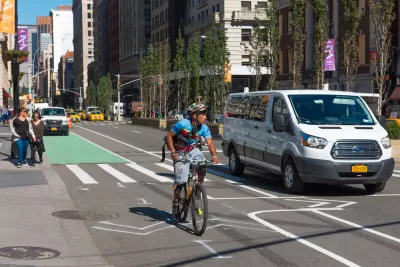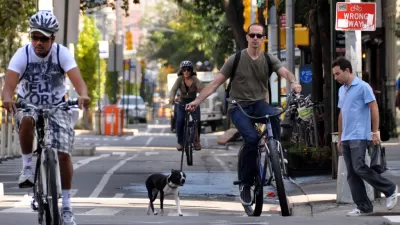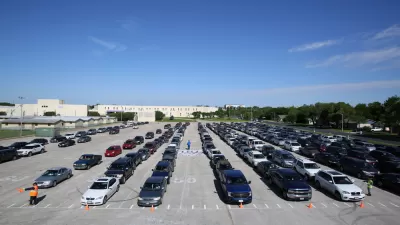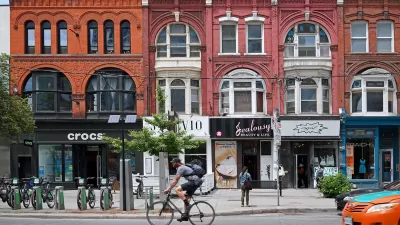Could the pandemic be a tipping point for a century of car-centric planning in New York City's to give way to a more bike-friendly city?

New York Times architecture critic Michael Kimmelman surveys the changing politics of bike planning in New York City, as evidenced by a slew of innovations implemented as public health and economic stimulus actions during the pandemic. Kimmelman starts off by describing recent planning developments, all documented previously Planetizen, as a glimmer of hope for a change to planning in the city.
- 'Open Restaurants on Open Streets' Program Announced in NYC (July 6, 2020)
- Electric Bikes and Scooters Legalized in New York City (June 29, 2020)
- First New Bridge to Manhattan in Decades Proposed Just for Pedestrians and People on Bikes (June 25, 2020)
- Bike-Centered Brooklyn Bridge Redo Under Consideration (June 22, 2020)
- Five Borough Bikeway Plan Released (June 18, 2020)
- Court Decision Clears the Way for East River Greenway Bike Bridge (May 12, 2020)
- Signal Priority in N.Y.C. to Make Streets Safer for Cyclists (November 6, 2019)
According to Kimmelman, the city is faced with two particularly ambitious potential paths forward to ensure a more bike-friendly future: the Regional Plan Association's Five Borough Bikeway Plan and the Queens Ribbon Bridge. The time is now to act on plans like these, argues Kimmelman:
Getting through this whole crisis depends on city leaders’ capacity to think ahead, not hunker down. Robert Moses, New York’s storied planning czar, plotted during the depths of the Depression so he could be ready when the money materialized. Whatever else one might say about Moses, he knew how to get stuff done.
By contrast, New York today has become good at shooting down new ideas, celebrating defeat over compromise, pointing out why any big, costly initiative is not worth pursuing because something else also needs doing, as if a great city shouldn’t find ways to do more than one thing at a time.
The city has changed before, according to one of the big statements included in this article. The current economic and public health crisis could provide another tipping point.
FULL STORY: New York as a Biking City? It Could Happen. And It Should.

Trump Administration Could Effectively End Housing Voucher Program
Federal officials are eyeing major cuts to the Section 8 program that helps millions of low-income households pay rent.

Planetizen Federal Action Tracker
A weekly monitor of how Trump’s orders and actions are impacting planners and planning in America.

Ken Jennings Launches Transit Web Series
The Jeopardy champ wants you to ride public transit.

Opinion: Transit Agencies Must View Service Cuts as Last Resort
Reducing service could cripple transit systems by pushing more riders to consider car ownership, making future recovery even less certain.

‘Smart Surfaces’ Policy Guide Offers Advice for Building and Maintaining Urban Tree Canopies
Healthy, robust tree canopies can reduce the impacts of extreme heat and improve air quality.

New Jersey Lawsuit Targets Rent-Setting Algorithms
The state of New Jersey is taking legal action against landlords and companies that engage in what the state’s Attorney General alleges is illegal rent fixing.
Urban Design for Planners 1: Software Tools
This six-course series explores essential urban design concepts using open source software and equips planners with the tools they need to participate fully in the urban design process.
Planning for Universal Design
Learn the tools for implementing Universal Design in planning regulations.
Heyer Gruel & Associates PA
Ada County Highway District
Institute for Housing and Urban Development Studies (IHS)
City of Grandview
Harvard GSD Executive Education
Toledo-Lucas County Plan Commissions
Salt Lake City
NYU Wagner Graduate School of Public Service





























